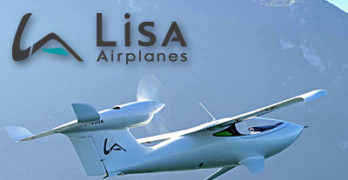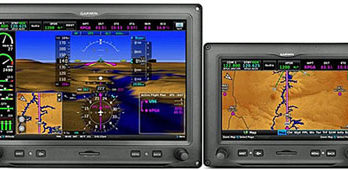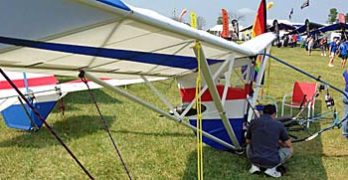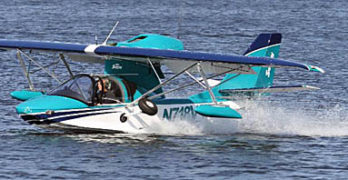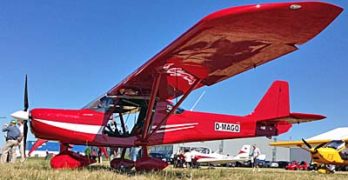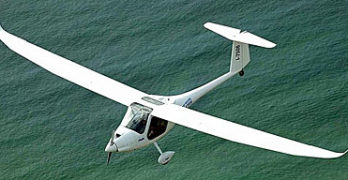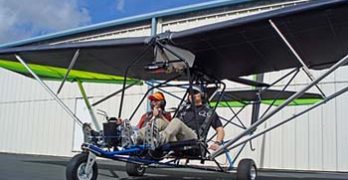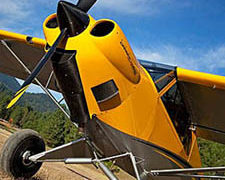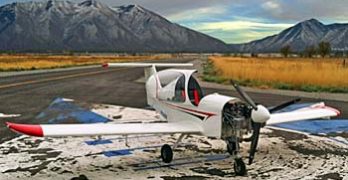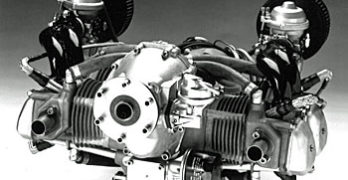We just passed September 1st and that date is significant in the LSA universe. It is the day, ten years ago, that the Sport Pilot & Light-Sport Aircraft rule we have been celebrating all summer officially became part of the Federal Aviation Regulations (FARs). If you’re thinking, “Hey, I thought it was announced in the summertime, at AirVenture!” … you’re correct. It was, but that was just the administrator’s public relations timing to get the biggest bang for the buck, at Oshkosh. As we continue the tenth anniversary celebration — looking back on the first decade — we see the astounding development of 136 models of LSA, more than one every month for ten years running. This profusion of models runs the length and breadth of aviation, from fixed wing, three axis airplanes to powered parachutes to trikes to motorgliders and from less than $30,000 to over $200,000. I fully expect designers to continue pushing the envelope in every direction but one facet of LSA development seems as energized as a Saturn V moon rocket: LSA seaplanes.
Search Results for : Icon
Not finding exactly what you expected? Try our advanced search option.
Select a manufacturer to go straight to all our content about that manufacturer.
Select an aircraft model to go straight to all our content about that model.
Final Newsbits Before AirVenture 2014 Starts
Garmin has a new smaller version of their very impressive G3X Touch. I examined this at Sun ‘n Fun when it was debuted in the 10-inch screen and came away highly impressed after two reviews on videos. For a billion-dollar company Garmin remains passionately inventive and surprisingly nimble. They keep the heat on now introducing a 7-inch G3X Touch display, described as “a high-resolution infrared touchscreen display designed for experimental amateur-built and Light-Sport Aircraft to compliments their existing 10.6-inch G3X Touch system.” Pilots and homebuilders concerned about instrument panel height and width constraints should be pleased to have the 7-inch option. All G3X Touch displays support Connext that allows wireless flight plan transfer between the company’s Garmin Pilot app on an iOS or select Android mobile device. “A well-equipped 7-inch G3X Touch system, which includes SVX, video input, a built-in WAAS GPS receiver, ADAHRS, magnetometer, OAT probe, interactive mapping and more, starts at $4,599,” said Garmin officials.
Affordable EMG … Electric Motor Glider
Update 8/8/14 — See our video interview about EMG at the end. An unpowered EMG — or Electric Motor Glider — from Adventure Aircraft has already taken 400 flights; it has also been fitted with a small electric motor … complete with carbon folding prop. A new Experimental Amateur Built (EAB) two seater is now taking shape and both variations were on exhibit at AirVenture 2014 in the newly named Fun Fly Zone (formerly Ultralight Area). EMG’s spark is provided by the dynamic duo of Brian and Carol Carpenter of Rainbow Aviation, well known for their LSA maintenance courses including the LSR-M (Light-Sport Repairman Maintenance) credential that has prepared many mechanics to do serious work on the growing fleet of LSA. EMG builder Adventure Aircraft is a subsidiary of Rainbow. Evidently this hard working pair aren’t fond of wasting many hours with something so mundane as sleep because the project is unfolding quite swiftly.
Searey Expands into China; Opens Sales Office
The list of aviation companies involved in one way or another with China is getting so long I won’t try to show them all here. Big companies like Cirrus Design or Continental are included. So are LSA manufacturers of various brands. Some business are setting up dealerships (Quicksilver, others). Others have arranged Chinese partners to build planes in-country (Flight Design, Zenith, others). Several companies have been fully acquired by or have received substantial funding from Chinese enterprises (Icon, others) and I’m aware of more that we will hear more about in the weeks and months to follow. The U.S. government and many other nations have borrowed from the Chinese government so a nearly unfathomable amount of dollars or other currencies are parked in China. However, most of the aviation financial arrangements are private, showing that, like their government, Chinese business people have plenty of funds to invest.
Flying Serbia’s Light-Sport Aircraft Entry
Update April 13, 2018 — At Sun ‘n Fun 2018, I was shown documents and photos to suggest the problem was the opposite of what appears in the following paragraph. Without legal discovery, for which I am not qualified, it is challenging to sort out the truth, however, based on the four years of history that has followed this story, I’m inclined to believe Aeroeast is a legitimate producer. In any event, as the aircraft has since changed in many ways, I consider the matter closed and wish Aeroeast good success in the future. —DJ
Update August 10, 2014 — At AirVenture 2014, I was informed that Aero-East-Europe’s Sila 450 is significantly based on a Max Tedesco design. When I heard this comment, I recall I had looked at the Serbian aircraft featured in the following article and thought it looked vaguely familiar. Many aircraft designs share a resemblance so I didn’t think much of it and I was no where near any of Tedesco’s airplanes to have a comparison.
2013 Light-Sport Market Share Report & Analysis
UPDATE: May 27, 2014 — “A vigorous debate ensued …” might be one way to refer to a four-way discussion from around the globe. Over the last few days, LSA industry folks in distant lands worked on market share details. Michael Coates is the Australian-based U.S. distributor for Pipistrel, an aircraft fabricated in Slovenia and assembled as a LSA in nearby Italy for shipment to the USA. My Czech-based associate, Jan Fridrich, was in China again because his country works with that nation as they build a personal aviation sector virtually from scratch. From our corners of the world we tried to resolve a problem that regularly occurs in our study of the FAA registration database. Pipistrel maintained their SLSA airplane numbers were stronger. Jan and I communicated and finally agreed that we were underreporting their numbers. The chart below has been modified to reflect a truer situation, sharply moving Pipistrel upward from 20th to 14th rank.
New SLSA (#135) is Quicksilver’s Sport S2SE
Once upon a time, a couple years before the SP/LSA was announced at AirVenture 2004, I thought the odds were high that Quicksilver would be the very first Special LSA to hit the market. Several other industry veterans agreed. Their GT500 was the very first to earn FAA’s Primary Category approval, back in 1993. This was a costlier effort than achieving ASTM compliance and so it seemed a done deal that Quicksilver would gain quick approval. I was wrong. Indeed, I was wrong by a dozen years. However, that’s over now as the Temecula, California company earned FAA acceptance for their Sport 2S side-by-side open-cockpit aircraft. In mid-April, FAA sent a letter saying all was well and the company can go forward with manufacturing. With their approval earned, Quicksilver’s S2SE is number 135 on our list of SLSA.
Will Escutia, president of Quicksilver Aeronautics, explained that the California company used “L-S2S” (the Light-Sport version of their strutted 2S) as the model name during the certification process.
An Impressive Record and Benchmark for CubCrafters
Should the expression be “You can keep a good thing up?” It is more positive than “You can’t keep a good man down.” Up, in this case, is CubCrafters and their climb in market share rank. The Yakima, Washington company logged another record year in 2013 and hit an impressive benchmark as the engines of demand and production paint a picture of a revved-up juggernaut. Congratulations to CubCrafters but the real reward for their team is a steady stream of customers that are convinced by the innovative re-creation of one of aviation’s most iconic designs. Among many smart decisions was the addition of the big 180-horsepower Titan 340CC engine, built by ECi, which gives the machine such exciting performance. I wonder if William Piper ever envisioned a CarbonCub SS.
CubCrafters delivered 63 new airplanes during 2013, soundly beating their solid performance of 48 CubCrafters in 2012.
SkyCraft Updates Progress on their SD-1 Minisport
After making a big splash at AirVenture Oshkosh 2013, the young team from SkyCraft Airplanes went home, rolled up their sleeves, and have been burning the midnight oil preparing the affordably priced single seater to meet ASTM standards and gain FAA’s nod for production. For those less informed, meeting the new industry consensus standards to earn government acceptance is a sharp deviation from FAA Type Certification. The task nonetheless represents a very significant work effort involving dozens of detailed tests and 100 hours of flight testing supported by hundreds of pages of documentation (read our earlier assessment of the costs involved). Even a well heeled organization like Icon has taken years to get all the pieces in place.
However, sometimes a smaller, more nimble organization with very clear goals can go more speedily through the process. SkyCraft Airplanes is composed of an energetic group lead by CEO Tyler Ives.
“Engine that Changed Aviation” — Rotax 912
The big company bills the now-iconic Rotax 9-series engines as “The Engine that Changed Light Aviation.” Today, few would dispute the claim that the 912 altered light aviation with its low weight and modern design, although Continental Motors, Lycoming, and others have long supplied powerplants for the light aircraft of earlier periods. On Valentine’s Day 2014, Rotax BRP celebrates the 25th Anniversary of its Rotax 912 engine. The four cylinder engine series that now dominates the light aircraft landscape got started in 1989 and was introduced to Americans a couple years later. The company started production of aircraft engines in 1973. Their first certified aircraft engine was delivered in 1975.
In answering the question about the potential for a new aircraft engine, Rotax BRP said it perceived, “… market demand … for a modern, reliable engine that would meet the expected performance. In 1985, the company started the development of a two-cylinder flat engine especially for the aircraft business.
- « Previous Page
- 1
- …
- 17
- 18
- 19
- 20
- 21
- …
- 28
- Next Page »


